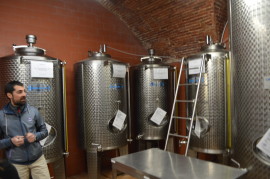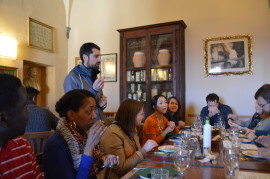As our group took to the cars and departed Florence city center, there was a peaceful serenity that enveloped us as we climbed the hills surrounding Florence and gazed upon the olive tree laden hillsides. We were greeted enthusiastically by Tomas as we entered Fattoria de Maiano and were provided a brief history of the estate and the olive production process.
I was especially intrigued by the fact that the site was at one time an old convent and a quarry (14th century) that provided the marble and stone for the majority of the buildings in the city of Florence, including the Duomo, at that time.
 We were first shown The Villa di Maiano, the impressive main house on the estate, which still had the original décor and furnishings and was the set for the films Tea with Mussolini and A Room with a View. We toured through the house, the exterior garden and terrace. Awed by the views, we saw the working olive farm situated on nearly 300 hectares of land encompassing nearly 20,000 olive trees.
We were first shown The Villa di Maiano, the impressive main house on the estate, which still had the original décor and furnishings and was the set for the films Tea with Mussolini and A Room with a View. We toured through the house, the exterior garden and terrace. Awed by the views, we saw the working olive farm situated on nearly 300 hectares of land encompassing nearly 20,000 olive trees.
The estate had passed through various owners and was purchased by Sir John Temple Leader in 1844. Leader with his wife, revitalized the estate and surrounding areas until his death in 1903 when possession was transferred to Professor Teodoro Stori, a famous Florentine surgeon. His niece, Countess Lucrezia Miari Fulcis dei Principi Corsini, inherited the Villa, and her children and grandchildren continue to work the farm and estate today.
 From the villa, Tomas graciously gave us a tour of the estate mill and described the olive oil production process. I was impressed when he said that the olives are picked entirely by hand and that the estate is completely organic. The olives are typically picked in November and December, and they are processed in the olive mill via a cold extraction process within 6.5 hours of being picked.
From the villa, Tomas graciously gave us a tour of the estate mill and described the olive oil production process. I was impressed when he said that the olives are picked entirely by hand and that the estate is completely organic. The olives are typically picked in November and December, and they are processed in the olive mill via a cold extraction process within 6.5 hours of being picked.
It was such a learning experience as he described how the olives are first separated from the leaves in the hopper and various conveyor belts before being crushed through a series of disks in the olive press. The oil is then separated from the olive rinds in a double centrifugal press, whose operation naturally pushed the oil one direction and the olive rinds the other. After separating the various lots, the olive oil is stored in airtight drums until receipt of the order that requires the bottling process.
 When I first learned of the trip, and the support it had received from the CHS Foundation to gain exposure to the agriculture industry, I was excited at the opportunity to learn more about the food products I use in my everyday life. Fattoria de Maiano did not disappoint. It was incredible to see the entire process and to learn exactly how extra virgin olive oil is characterized and the difference from regular virgin olive oil – extra virgin olive oil comes from the first pressing of the olives, contains no more than 0.8% acidity, and is judged to have superior taste.
When I first learned of the trip, and the support it had received from the CHS Foundation to gain exposure to the agriculture industry, I was excited at the opportunity to learn more about the food products I use in my everyday life. Fattoria de Maiano did not disappoint. It was incredible to see the entire process and to learn exactly how extra virgin olive oil is characterized and the difference from regular virgin olive oil – extra virgin olive oil comes from the first pressing of the olives, contains no more than 0.8% acidity, and is judged to have superior taste.

Olive oil tasting.
It was awesome to taste their regular extra virgin olive oil and compare it with their premium extra virgin olive oil, Laudemio, which has won awards in Los Angeles and Tokyo. This was a fantastic visit with wonderful hospitality and information, and if I am ever in the area in the future, I look forward to visiting Fattoria de Maiano again.
I am thankful for the support from CHS, and the CHS Foundation, for allowing us the opportunity to take an in depth look at agricultural products we use in our daily lives. This has been a once in a lifetime experience and I am grateful for the support from CHS for making it possible.
Guest Blogger: Kimberly Holden, MBA’15



